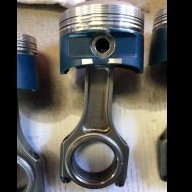Announcements
-
Similar Content
-
Latest Posts
-
By funkymonkey · Posted
Por que no los dos? At least my euro brawler is reliable - unlike the JDMs I've had. Sheraaz you look familiar, did you ever come to an SAU VIC meet aaaaaages ago? -
By funkymonkey · Posted
Drove to Cape Schanck to try to get a nice clear southern view over the ocean to see the lights a couple of days ago... instead got crappy cloud cover. Photo of a diorama of Hong Kong street scene. Taken on an iPhone 13 Pro Max. -
Stock RB fuel pressure is near enough 43.5 psi, so the latency in that table at 31.6 will be close. You can see that 7 or 8 psi equates to about 0.4µs extra latency. So if you wanted to interpolate between the 31.6 and 39.9 psi values you could say you're going up about 2 psi out of those 8, so add about 0.1µs, which is barely worth talking about and is quite possibly wrong because ideally you would fix the latency while running at the appropriate conditions on the dyno, with a wideband sniffing its butt.
-
The pressure, is what you set the fuel pressure to. If you have the factory fuel reg, you'll need to find the factory spec. I don't know it off the top of my head, but someone else might.
-
For others, what GTSBoy states here should be paid attention. Why? Well lots of people play with different engines, and they LOVE to change things like remove AC, or steering pumps etc, and it lends to them needing to move the tensioner too. You want your tensioner, particularly those that are sprung or hydraulically tensioned, to be the first thing after the harmonic balancer, or technically the "last" pulley in the chain. By saying last pulley, I mean look at the direction the crank spins when the engine is running, follow the belt from where the crank is pulling the belt FROM, and keep following that until you're between the last pulley/accessory on the belt and about to reach the crank again, this is the spot where you put the tensioner. This is the area that will always end up with slack. This is worked out exactly the same way for chains too, as the physics is the same for them. The crank pulley is where all the force to drag the belt around comes from. You will never ever get rid of the slack that appears, especially under load. The tensioners job is to keep the belt loose enough when stationary that there shouldn't be out of sync movement in slow movement, and then be tight enough when running, that the belt can't jump off any gear and get damaged. Too tight, bad things happen, too loose, bad things happen. Have a tensioner (mainly sprung/hydraulic one) in the wrong spot, it can't actually do anything about keeping the tension.
-





Recommended Posts
Create an account or sign in to comment
You need to be a member in order to leave a comment
Create an account
Sign up for a new account in our community. It's easy!
Register a new accountSign in
Already have an account? Sign in here.
Sign In Now